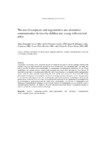The use of computers and augmentative and alternative communication devices by children and young with cerebral palsy

View/
Use this link to cite
http://hdl.handle.net/2183/18339Collections
- Investigación (FIC) [1685]
Metadata
Show full item recordTitle
The use of computers and augmentative and alternative communication devices by children and young with cerebral palsyDate
2011-09-09Citation
Pousada García T, Pereira Loureiro J, Groba González B, Nieto Riveiro L, Pazos Sierra A. The use of computers and augmentative and alternative communication devices by children and young with cerebral palsy. Assist Technol. 2011;23(3):135-49
Abstract
[Abstract] The purpose of the study was to determine the use of computers and assistive devices amongst children with cerebral palsy (CP) and establish the satisfaction level of both users and educational staff. The study was carried out with 30 children with cerebral palsy. A questionnaire was designed to characterize the use of new technologies and assistive devices. Some of the questions were reserved for the teachers. Even though 29 users show some type of communication difficulty, only 4 users dispose of a computer-aided communication device, with the static symbolic board being the most widely used device (4). More than half of the participants (17) regularly use a computer, 16 of them requiring some type of assistive device. The perception of the teachers with regard to the use of Information and Communications Technologies (ICTs) in the classrooms is positive in 5 out of 6 cases. ICTs only provide assistance if their application is accompanied by the involvement of professionals and the child's social environment. The low use of Augmentative and Alternative Communication techniques along with the absence of communication codes reveal the need to establish training protocols. The inclusion of social, physical, and personal factors is considered essential in order to evaluate the needs for assistive technology.
Keywords
Assistive technology
Cerebral palsy
Augmentative and alternative communication
Computer access
Special education
Cerebral palsy
Augmentative and alternative communication
Computer access
Special education
Editor version
Rights
This is an accepted manuscript of an article published by Taylor & Francis in Taylor & Francis Online
ISSN
1040-0435
1949-3614
1949-3614





